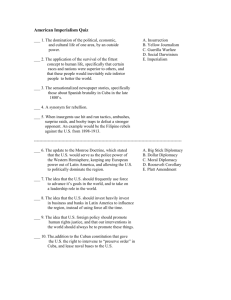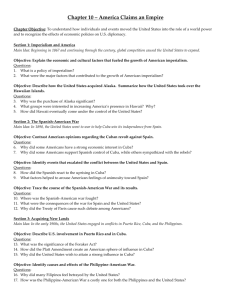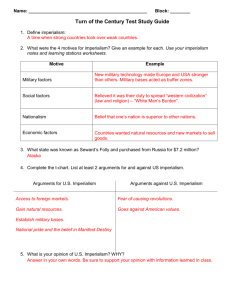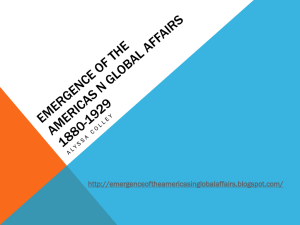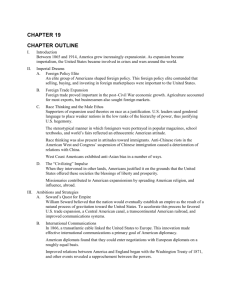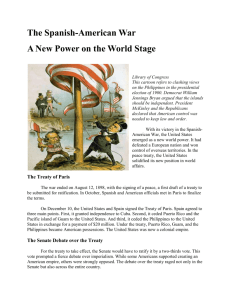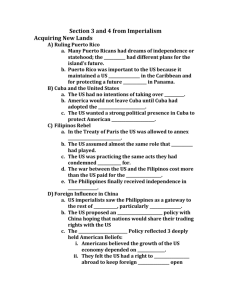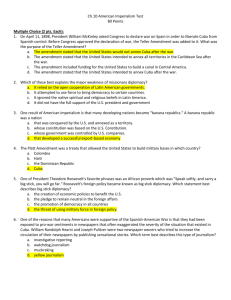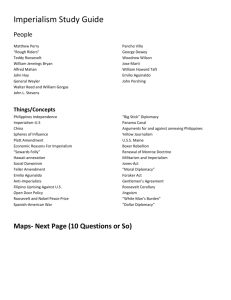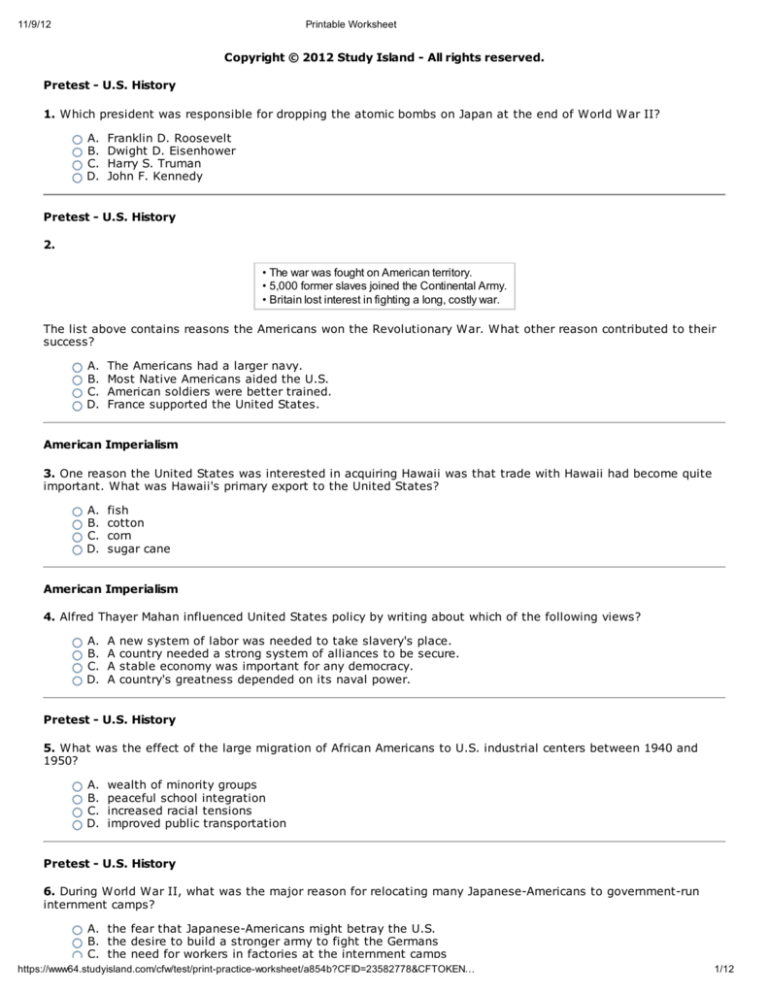
11/9/12
Printable Worksheet
Copyright © 2012 Study Island - All rights reserved.
Pretest - U.S. History
1. Which president was responsible for dropping the atomic bombs on Japan at the end of World War II?
A.
B.
C.
D.
Franklin D. Roosevelt
Dwight D. Eisenhower
Harry S. Truman
John F. Kennedy
Pretest - U.S. History
2.
• The war was fought on American territory.
• 5,000 former slaves joined the Continental Army.
• Britain lost interest in fighting a long, costly war.
The list above contains reasons the Americans won the Revolutionary War. What other reason contributed to their
success?
A.
B.
C.
D.
The Americans had a larger navy.
Most Native Americans aided the U.S.
American soldiers were better trained.
France supported the United States.
American Imperialism
3. One reason the United States was interested in acquiring Hawaii was that trade with Hawaii had become quite
important. What was Hawaii's primary export to the United States?
A.
B.
C.
D.
fish
cotton
corn
sugar cane
American Imperialism
4. Alfred Thayer Mahan influenced United States policy by writing about which of the following views?
A.
B.
C.
D.
A
A
A
A
new system of labor was needed to take slavery's place.
country needed a strong system of alliances to be secure.
stable economy was important for any democracy.
country's greatness depended on its naval power.
Pretest - U.S. History
5. What was the effect of the large migration of African Americans to U.S. industrial centers between 1940 and
1950?
A.
B.
C.
D.
wealth of minority groups
peaceful school integration
increased racial tensions
improved public transportation
Pretest - U.S. History
6. During World War II, what was the major reason for relocating many Japanese-Americans to government-run
internment camps?
A. the fear that Japanese-Americans might betray the U.S.
B. the desire to build a stronger army to fight the Germans
C. the need for workers in factories at the internment camps
https://www64.studyisland.com/cfw/test/print-practice-worksheet/a854b?CFID=23582778&CFTOKEN…
1/12
11/9/12
Printable Worksheet
C. the need for workers in factories at the internment camps
D. the desire of most Japanese-Americans to escape to Japan
American Imperialism
7. Why did President McKinley believe it was important for the United States to become involved in Cuba's
interests prior to the Spanish American War?
A.
B.
C.
D.
He promised the Cubans defense against any foreign enemy.
He wanted to protect American economic interests in the Caribbean.
Cuba was a strong ally and a potential trading partner of the U.S.
He wanted to defeat the Spanish in order to gain more land.
American Imperialism
8. Which treaty ended the Spanish-American War?
A.
B.
C.
D.
the
the
the
the
Treaty of Ghent
Treaty of Paris of 1898
Hay-Bunau-Varilla Treaty
Treaty of Versailles
Pretest - U.S. History
9. Which of the following best describes the U.S. foreign policy of containment used during the Cold War?
A.
B.
C.
D.
The
The
The
The
U.S.
U.S.
U.S.
U.S.
wanted to prevent the spread of communism.
worked to maintain peace throughout the world.
hoped to become more allied with the Soviet Union.
wanted to become less involved in foreign affairs.
American Imperialism
10. The U.S. became a superpower around the turn of the twentieth century. This was because the U.S. was able
to create a stepping stone to the commerce of
A.
B.
C.
D.
Africa.
Cuba.
Spain.
Asia.
Pretest - U.S. History
11.
• favored a strong national government
• favored a national bank
• was supported by bankers, merchants and other businessmen
Which 18th century political party is described in the box above?
A.
B.
C.
D.
Democratic-Republican
Whig
Populist
Federalist
Pretest - U.S. History
12. The basic ideas behind the Nullification Crisis were also among the basic ideas behind which of the following
American events?
A.
B.
C.
D.
the
the
the
the
Dawes Act
Civil War
Mexican War
Chinese Exclusion Act
https://www64.studyisland.com/cfw/test/print-practice-worksheet/a854b?CFID=23582778&CFTOKEN…
2/12
11/9/12
D. the Chinese Exclusion Act
Printable Worksheet
Pretest - U.S. History
13.
There comes a time when people get tired of being trampled over by the iron feet of oppression. . . . I want it to be known that we're
going to work with grim and bold determination to gain justice on the buses in this city. And we are not wrong. . . .
—Martin Luther King, Jr., 1965
According to this excerpt, what idea did Martin Luther King, Jr., oppose?
A.
B.
C.
D.
limited city
segregated
higher fees
restrictions
bus routes for African American riders
seating on Montgomery's city buses
charged to African American bus riders
on the hiring of minority bus drivers
American Imperialism
14. The Open Door Policy expanded international trade in which country?
A.
B.
C.
D.
China
Cuba
The Philippines
Mexico
Pretest - U.S. History
15. Which factor was a major cause of the Great Depression of the 1930s?
A.
B.
C.
D.
high protective tariff rates brought on by the McKinley Tariff of 1890
excessive borrowing to buy stocks leading to the stock market crash of 1929
farmers raising crop prices with the creation of the Federal Farm Marketing Board in 1930
increased taxes to pay veterans as demanded by the American Bonus Army in 1932
Pretest - U.S. History
16. During World War I, why did Germany feel it was justified in attacking the British passenger ship Lusitania?
A.
B.
C.
D.
German passenger ships were also attacked during the war.
The British were also using it to transport war materials.
The Lusitania had fired upon German ships.
It was Germany's policy to attack civilians.
Pretest - U.S. History
17. The leaders of which three countries were known as the "Big Three" during World War II?
A.
B.
C.
D.
United States, United Kingdom, and Soviet Union
Germany, Italy, and Japan
United Kingdom, France, and Germany
United States, Canada, and Mexico
American Imperialism
18. One result of American imperialism is that many developing nations became "banana republics." A banana
republic was a nation
A.
B.
C.
D.
that was conquered by the U.S. and annexed as a territory.
whose constitution was based on the U.S. Constitution.
whose government was controlled by U.S. companies.
that developed a successful export-based economy.
https://www64.studyisland.com/cfw/test/print-practice-worksheet/a854b?CFID=23582778&CFTOKEN…
3/12
11/9/12
Printable Worksheet
Pretest - U.S. History
19. Which of these people played a major role in helping to gain women the right to vote?
A.
B.
C.
D.
Margaret Sanger
Eleanor Roosevelt
Rosa Parks
Susan B. Anthony
Pretest - U.S. History
20. Which treaty brought an end to World War I but failed to maintain a lasting peace in Europe?
A.
B.
C.
D.
Treaty
Treaty
Treaty
Treaty
of
of
of
of
Paris
London
Ghent
Versailles
American Imperialism
21. The Platt Amendment was a treaty that allowed the United States to build military bases in which country?
A.
B.
C.
D.
Cuba
Colombia
Haiti
the Dominican Republic
American Imperialism
22. Why did President McKinley believe it was important for the United States to become involved in Cuba's
interests prior to the Spanish American War?
A.
B.
C.
D.
He wanted to defeat the Spanish in order to gain more land.
He wanted to protect American economic interests in the Caribbean.
He promised the Cubans defense against any foreign enemy.
Cuba was a strong ally and a potential trading partner of the U.S.
American Imperialism
23. In 1902, Secretary of State John Hay negotiated a treaty with Colombian Foreign Minister Tomás Herrán in
which the United States was granted permission to build a canal in Panama, which was controlled by Colombia at
the time. The U.S. Senate approved this treaty, but the Colombian government did not. What did the United States
do after the rejection of this treaty?
A. The United States
B. The United States
independent country.
C. The United States
D. The United States
started to build its canal even though it did not have approval.
assisted in a Panamanian revolt against Colombia, and Panama became an
imposed a trade embargo on Colombia.
declared war on Colombia.
American Imperialism
24. In an address to Congress in 1823, President James Monroe said that the Western Hemisphere was closed to
further European colonization and interference in political affairs. The ideas expressed in this speech became
known as the Monroe Doctrine and influenced American foreign policy up until the early 20th century. Which action
is an example of a U.S. intervention in foreign affairs that the U.S. claimed was justified by the principles set forth
in the Monroe Doctrine?
A. The United States appealed to China and other countries to open up foreign trade in China to all
countries.
B. The United States signed a treaty with Hawaii in 1875 that stated that the U.S. would not impose duties
on sugar imported from Hawaii.
C. In 1895, Secretary of State Richard Olney sent a letter to Great Britain asking them to use arbitration to
settle the boundary dispute between Venezuela and British Guiana.
D. Secretary of State William Seward signed a treaty with Russia in which the U.S. agreed to purchase
Alaska for $7.2 million.
https://www64.studyisland.com/cfw/test/print-practice-worksheet/a854b?CFID=23582778&CFTOKEN…
4/12
11/9/12
Printable Worksheet
Alaska for $7.2 million.
Pretest - U.S. History
25. Which states were added in the Union in 1820 as part of a compromise to keep the balance of slave and free
states?
A.
B.
C.
D.
Kansas and Missouri
Missouri and Maine
Maine and California
West Virginia and Ohio
American Imperialism
26. In 1902, Secretary of State John Hay negotiated a treaty with Colombian Foreign Minister Tomás Herrán in
which the United States was granted permission to build a canal in Panama, which was controlled by Colombia at
the time. The U.S. Senate approved this treaty, but the Colombian government did not. What did the United States
do after the rejection of this treaty?
A. The United States
B. The United States
independent country.
C. The United States
D. The United States
declared war on Colombia.
assisted in a Panamanian revolt against Colombia, and Panama became an
started to build its canal even though it did not have approval.
imposed a trade embargo on Colombia.
Pretest - U.S. History
27. Which statement most accurately explains the result of the Connecticut Compromise?
A.
B.
C.
D.
It
It
It
It
resolved the debate over slavery and commercial trade.
settled a debate over representation in Congress.
established the Northwest Ordinance of 1787.
settled the dispute over the Electoral College.
Pretest - U.S. History
28. In the 1840s, the slogan "54-40 or Fight!" was used to support American annexation of
A.
B.
C.
D.
New Mexico.
California.
Texas.
Oregon.
American Imperialism
29. One of the reasons that many Americans were supportive of the Spanish-American War is that they had been
exposed to pro-war sentiments in newspapers that often exaggerated the severity of the situation that existed in
Cuba. William Randolph Hearst and Joseph Pulitzer were two newspaper owners who tried to increase the
circulation of their newspapers by publishing sensational stories. Which term best describes this type of
journalism?
A.
B.
C.
D.
yellow journalism
investigative reporting
muckraking
watchdog journalism
American Imperialism
30. What was the first territory that the United States acquired in the Pacific Ocean?
A.
B.
C.
D.
Hawaii
Samoa
The Philippines
Guam
https://www64.studyisland.com/cfw/test/print-practice-worksheet/a854b?CFID=23582778&CFTOKEN…
5/12
11/9/12
Printable Worksheet
Pretest - U.S. History
31. The concept of "big stick diplomacy," which is the threat of using military force in foreign policy, is most
associated with which person's presidency?
A.
B.
C.
D.
Herbert Hoover
Theodore Roosevelt
Harry S. Truman
Woodrow Wilson
Pretest - U.S. History
32. Which of the following is one of the reasons that the United States invaded Iraq in 2003?
A.
B.
C.
D.
The
The
The
The
U.S.
U.S.
U.S.
U.S.
wanted to liberate Kuwait which had been invaded by Iraq.
believed that Iraq was protecting al Qaeda and Osama bin Laden.
believed that Iraq possessed weapons of mass destruction.
wanted to take control of Iraq's oil fields.
American Imperialism
33. President William Howard Taft's foreign policy encouraged American investment in foreign countries and
increased trade. What was the name given to Taft's foreign policy?
A.
B.
C.
D.
dollar diplomacy
missionary diplomacy
big stick diplomacy
shuttle diplomacy
American Imperialism
34. Which event contributed to the outbreak of the Spanish-American War?
A.
B.
C.
D.
the
the
the
the
sinking of the Lusitania
border dispute between Venezuela and British Guiana
sinking of the USS Maine
construction of the Panama Canal
American Imperialism
35. The Platt Amendment was a treaty that allowed the United States to build military bases in which country?
A.
B.
C.
D.
the Dominican Republic
Haiti
Colombia
Cuba
Pretest - U.S. History
36. Which Supreme Court ruling determined that segregation in the public school system was unconstitutional?
A.
B.
C.
D.
Roe v. Wade
Brown v. Board of Education
Plessy v. Ferguson
Marbury v. Madison
American Imperialism
37.
The White Man's Burden
The United States and
the Philippine Islands
https://www64.studyisland.com/cfw/test/print-practice-worksheet/a854b?CFID=23582778&CFTOKEN…
6/12
the Philippine Islands
by Rudyard Kipling
Take up the White Man's burden—
Send forth the best ye breed—
Go, bind your sons to exile
To serve your captives' need;
To wait, in heavy harness,
On fluttered folk and wild—
Your new-caught sullen peoples,
Half devil and half child.
Take up the White Man's burden—
The savage wars of peace—
Fill full the mouth of Famine,
And bid the sickness cease;
And when your goal is nearest
(The end for others sought)
Watch sloth and heathen folly
Bring all your hope to nought.
Above are two stanzas of "The White Man's Burden," which was published after the United States acquired the
Philippine Islands. The poem argues that the natives of the Philippines
A.
B.
C.
D.
were threatening to other nations of the world.
had valuable resources that were being wasted.
had helped the United States in the past.
were not able to take care of themselves.
American Imperialism
38. President William Howard Taft's foreign policy encouraged American investment in foreign countries and
increased trade. What was the name given to Taft's foreign policy?
A.
B.
C.
D.
shuttle diplomacy
dollar diplomacy
big stick diplomacy
missionary diplomacy
American Imperialism
39. Which of these best explains the major weakness of missionary diplomacy?
A.
B.
C.
D.
It
It
It
It
did not have the full support of the U.S. president and government.
relied on the open cooperation of Latin American governments.
ignored the native spiritual and religious beliefs in Latin America.
attempted to use force to bring democracy to certain countries.
Pretest - U.S. History
40. Which of the following best explains why the United States became involved in the Vietnam War?
A.
B.
C.
D.
The
The
The
The
U.S.
U.S.
U.S.
U.S.
wanted to control all of North and South Vietnam.
wanted to prevent the spread of communism in Southeast Asia.
was helping North Vietnam defend itself from South Vietnam.
mainland had been attacked by the Vietnamese.
Pretest - U.S. History
41. Which industry was most affected by the Pullman Strike of 1894?
A.
B.
C.
D.
steel
coal
railroad
oil
11/9/12
Printable Worksheet
American Imperialism
42. Which of these territories did the United States acquire as a result of the Spanish-American War?
A.
B.
C.
D.
Panama
Hawaii
the Dominican Republic
the Philippines
Pretest - U.S. History
43. Which battle in the American Revolution resulted in the surrender of the British forces?
A.
B.
C.
D.
Battle
Battle
Battle
Battle
of
of
of
of
Trenton
Saratoga
Yorktown
Charleston
Pretest - U.S. History
44. How did industrialization during the late 1800s contribute to the development of organized labor?
A.
B.
C.
D.
by
by
by
by
paying individuals high wages and great benefits
contributing to the growth of college business programs
reducing the demand for new machinery in factories
creating low-skill jobs that made employees easy to replace
Pretest - U.S. History
45. How did the First Great Awakening contribute to the emergence of American identity?
A.
B.
C.
D.
It
It
It
It
helped
helped
helped
helped
establish
establish
establish
establish
an emphasis on education.
consent of the governed.
separation of church and state.
religious pluralism.
American Imperialism
46. One of President Theodore Roosevelt's favorite phrases was an African proverb which was "Speak softly, and
carry a big stick, you will go far." Roosevelt's foreign policy became known as big stick diplomacy. Which statement
best describes big stick diplomacy?
A.
B.
C.
D.
the
the
the
the
promotion of democracy in all countries
creation of economic policies to benefit the U.S.
threat of using military force in foreign policy
pledge to remain neutral in the foreign affairs
American Imperialism
47. On April 11, 1898, President William McKinley asked Congress to declare war on Spain in order to liberate Cuba
from Spanish control. Before Congress approved the declaration of war, the Teller Amendment was added to it.
What was the purpose of the Teller Amendment?
A.
B.
C.
D.
after
The amendment
The amendment
The amendment
The amendment
the war.
stated that the United States would not annex Cuba after the war.
stated that the United States intended to annex Cuba after the war.
included funding for the United States to build a canal in Central America.
stated that the United States intended to annex all territories in the Caribbean Sea
Pretest - U.S. History
48. What plan was supported by Franklin D. Roosevelt to get people working during the Great Depression?
A. Fair Deal
https://www64.studyisland.com/cfw/test/print-practice-worksheet/a854b?CFID=23582778&CFTOKEN…
8/12
11/9/12
Printable Worksheet
A.
B.
C.
D.
Fair Deal
New Deal
New Frontier
Great Society
American Imperialism
49. In a 1904 address to Congress, President Theodore Roosevelt stated that the United States would intervene in
the finances of countries in the Western Hemisphere who were unable to pay their debts to foreign creditors.
Known as the Roosevelt Corollary, this was an addition to which U.S. foreign policy?
A.
B.
C.
D.
the
the
the
the
Open Door Policy
Monroe Doctrine
Treaty of Paris of 1898
Hay-Bunau-Varilla Treaty
American Imperialism
50.
Which of the following best completes the chart?
A.
B.
C.
D.
the Dominican Republic
Haiti
Jamaica
the Philippines
American Imperialism
51. Which treaty granted the United States permission to build the Panama Canal?
A.
B.
C.
D.
the
the
the
the
Clayton-Bulwer Treaty
Hay-Bunau-Varilla Treaty
Hay-Pauncefote Treaty
Treaty of Paris of 1898
Pretest - U.S. History
52. Which of the following was one of the results of the Spanish-American War?
A.
B.
C.
D.
The
The
The
The
U.S.
U.S.
U.S.
U.S.
suffered a significant loss of life.
established itself as a global power.
gave up a great deal of territory to Spain.
became less interested in foreign affairs.
Answers
1.
2.
3.
4.
5.
6.
C
D
D
D
C
A
https://www64.studyisland.com/cfw/test/print-practice-worksheet/a854b?CFID=23582778&CFTOKEN…
9/12
11/9/12
Printable Worksheet
6. A
7. B
8. B
9. A
10. D
11. D
12. B
13. B
14. A
15. B
16. B
17. A
18. C
19. D
20. D
21. A
22. B
23. B
24. C
25. B
26. B
27. B
28. D
29. A
30. A
31. B
32. C
33. A
34. C
35. D
36. B
37. D
38. B
39. D
40. B
41. C
42. D
43. C
44. D
45. D
46. C
47. A
48. B
49. B
50. D
51. B
52. B
Explanations
3. Sugar cane was the major export from Hawaii to the United States. Under the Reciprocity Treaty of 1875,
Hawaii exported sugar to the United States, and the U.S. did not impose duties on the imported sugar.
4. Alfred Thayer Mahan wrote The Influence of Seapower Upon History in 1890. In this book, he argued that
naval power was the most important thing that a country could develop. Mahan's views left an impact on the
United States and other nations in the 1890s and early 1900s.
7. President McKinley felt the U.S. needed to get involved in Cuba's interests prior to the Spanish American War
for several reasons. Perhaps most importantly, the United States had developed an economic interest in Cuba
and in the Caribbean, especially in Cuban sugar plantations.
8. The Treaty of Paris of 1898 ended the Spanish-American War. Under the terms of the treaty, the United States
paid Spain $20 million to acquire the Philippines, Spain ceded Guam and Puerto Rico to the United States, and
Spain gave up control of Cuba.
10. One of the reasons for U.S. involvement in the Spanish American War was to increase its involvement in the
commerce of Asia. The United States was looking for new overseas markets to sell American products. The U.S.
knew that if it was to take islands in the Pacific, it would be able to create a stepping stone to Asia, where
lucrative commerce was taking place. Also, the United States was very interested in the raw materials found on
some of the Pacific islands.
https://www64.studyisland.com/cfw/test/print-practice-worksheet/a854b?CFID=23582778&CFTOKEN…
10/12
11/9/12
Printable Worksheet
14. Prior to the creation of the Open Door Policy, China had various sections of its country in which foreign
powers had exclusive rights to trade. Great Britain, France, Germany, Russia, and Japan all had territories in
which they controlled all foreign trade. The United States did not have one of these so called "spheres of
influence" and wanted to trade with the Chinese. The United States encouraged China and other foreign nations
to open up all areas to trade with all countries.
18. "Banana republic" was a name given to developing nations that were virtually controlled by United States
companies. U.S. private companies owned large banana plantations in many nations throughout Central America.
The governments of these nations were influenced by the companies, whose vast property could be protected by
the United States and its military. The most famous of these was the United Fruit Company, which began
running some of Guatemala's government services in 1901 and continued to influence its government through the
Cold War.
21. At the conclusion of the Spanish-American War, Cuba gained its independence from Spain. According to the
Teller Amendment of 1898, the United States had vowed not to annex Cuba. In the Platt Amendment, Cuba
granted the U.S. permission to build a naval base at Guantánamo Bay. The U.S. military presence in Cuba is one
example of how the U.S. intervened in Cuban affairs after its independence from Spain.
22. President McKinley felt the U.S. needed to get involved in Cuba's interests prior to the Spanish American War
for several reasons. Perhaps most importantly, the United States had developed an economic interest in Cuba
and in the Caribbean, especially in Cuban sugar plantations.
23. After the Colombian government rejected the Hay-Herrán Treaty, the United States assisted in Panama's
revolt against Colombia. Shortly after Panama declared its independence, the United States signed the HayBunau-Varilla Treaty in which the United States paid Panama $10 million for a ten-mile wide strip of land in
which the United States would build a canal and control the area.
24. Venezuela was an independent country, and Great Britain controlled British Guyana, which was to the east of
Venezuela. Great Britain had acquired British Guiana in 1814 by signing a treaty with the Netherlands, but the
treaty did not specify a border. In 1841, Venezuela disputed the border that Great Britain had claimed. This
disputed continued for the rest of the century. Venezuela asked the United States to intervene, and in 1895,
U.S. Secretary of State Richard Olney sent a letter to the British asking them to use arbitration to settle the
boundary dispute. An American boundary commission then settled the boundary dispute.
26. After the Colombian government rejected the Hay-Herrán Treaty, the United States assisted in Panama's
revolt against Colombia. Shortly after Panama declared its independence, the United States signed the HayBunau-Varilla Treaty in which the United States paid Panama $10 million for a ten-mile wide strip of land in
which the United States would build a canal and control the area.
29. Yellow journalism is the term used to describe the tactics used by William Randolph Hearst and Joseph
Pulitzer. In publishing sensational stories that often exaggerated the conditions in Cuba, these newspaper
owners contributed to the American public's support of the U.S. declaring war on the Spanish.
30. The United States annexed Hawaii in 1898, and it became the first U.S. territory in the Pacific. Hawaii was a
strategic location for the U.S. for it to expand its commercial and military presence in the Pacific. The U.S. built a
naval base at Pearl Harbor, and Hawaii was an important stop on commercial trade routes to Asia.
33. Dollar diplomacy is the term used to describe Taft's foreign policy. Taft wanted to create economic stability
in foreign countries in order to promote America's commercial interests.
34. Cuba, a Spanish territory in the Caribbean, had staged several revolts for independence in the late 1800s.
Many Americans had investments in Cuba and favored Cuban independence. On February 15, 1898, the USS
Maine sank in the harbor of Havana, Cuba. Although the cause of the explosion was unknown, some Americans
blamed the Spanish and advocated war with them.
35. At the conclusion of the Spanish-American War, Cuba gained its independence from Spain. According to the
Teller Amendment of 1898, the United States had vowed not to annex Cuba. In the Platt Amendment, Cuba
granted the U.S. permission to build a naval base at Guantánamo Bay. The U.S. military presence in Cuba is one
example of how the U.S. intervened in Cuban affairs after its independence from Spain.
37. Kipling's poem "The White Man's Burden" was published in 1899. It set forth the belief that people like those
who lived in the Philippine Islands were ignorant natives who could not take care of themselves. Therefore, the
United States had a duty to help the Philippines by taking them as a colony. In modern times, the idea of "white
man's burden" is generally seen as a form of racism that justified imperialism. If you look at the poem, phrases
like "sloth and heathen folly" show the belief that native people were not as intelligent or hard-working as
Americans. Phrases like "half devil and half man" show the belief that the natives may have been less human
than whites.
38. Dollar diplomacy is the term used to describe Taft's foreign policy. Taft wanted to create economic stability
in foreign countries in order to promote America's commercial interests.
39. Missionary diplomacy (sometimes referred to as moral diplomacy) was a U.S. foreign policy on Latin America
during the administration of President Woodrow Wilson. Under Missionary Diplomacy, the United States
attempted to spread democracy to other nations of the western hemisphere. Wilson believed that a democratic
https://www64.studyisland.com/cfw/test/print-practice-worksheet/a854b?CFID=23582778&CFTOKEN…
11/12
11/9/12
Printable Worksheet
attempted to spread democracy to other nations of the western hemisphere. Wilson believed that a democratic
system would bring as much success to Latin American nations as it had to the United States. Unfortunately,
this meant that Wilson often used the U.S. military to forcibly remove Latin American governments he did not
approve of. The U.S. intervened in Mexico, Haiti, Cuba, Panama, and Nicaragua during Wilson's presidency.
42. The United States fought in the Spanish-American War to liberate Cuba from Spanish rule. Some of the
fighting in this war took place in the Philippines, a Spanish colony in southeast Asia. The Spanish-American War
ended with the signing of the Treaty of Paris of 1898. Under the terms of the treaty, the United States paid
Spain $20 million to acquire the Philippines, Spain ceded Guam and Puerto Rico to the United States, and Spain
gave up control of Cuba.
46. Big stick diplomacy included the idea that military force should be used in order to protect America's
interests in foreign countries. President Roosevelt used big stick diplomacy in foreign policy issues related to
Latin America.
47. According to the Teller Amendment, the United States said that it would not annex Cuba. Some members of
Congress voted for this amendment because they feared that if the United States acquired Cuba, it would also
assume Cuba's large debt.
49. In the Roosevelt Corollary, President Theodore Roosevelt stated: "Chronic wrongdoing, or an impotence
which results in a general loosening of the ties of civilized society, may in America, as elsewhere, ultimately
require intervention by some civilized nation, and in the Western Hemisphere the adherence of the United States
to the Monroe Doctrine may force the United States, however reluctantly, in flagrant cases of such wrongdoing or
impotence, to the exercise of an international police power." The Roosevelt Corollary was Roosevelt's addition to
the Monroe Doctrine and was used to justify American intervention in several Latin American countries.
50. Under the terms of the Treaty of Paris of 1898, Spain ceded Guam and Puerto Rico to the United States.
Spain also sold the Philippines to the U.S. for $20 million. Filipinos, however, wanted to become an independent
country and fought against the U.S. In 1899, Emilio Aguinaldo declared himself president of the new Philippine
Republic, and shortly thereafter, the Philippine Republic declared war on the United States. The fighting
continued until 1902.
51. Panama and the United States signed the Hay-Bunau-Varilla Treaty shortly after Panama gained
independence from Colombia. Under the terms of this treaty, the U.S. paid Panama $10 million to lease a tenmile wide strip of land in which the U.S. could build the canal. The U.S. also agreed to pay Panama $250,000 per
year for the Canal Zone.
https://www64.studyisland.com/cfw/test/print-practice-worksheet/a854b?CFID=23582778&CFTOKEN…
12/12

